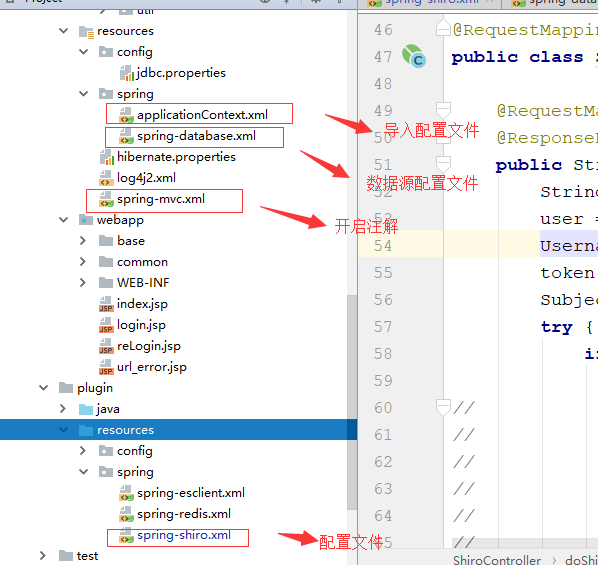开始之前一定要先看一下大神的:
Shiro学习--与SpringMVC整合(数据库,Shiro注解和Shiro标签
http://blog.csdn.net/frankcheng5143/article/details/50836619
1.使用maven,配置pom:
<!-- https://mvnrepository.com/artifact/org.apache.shiro/shiro-core -->
<dependency>
<groupId>org.apache.shiro</groupId>
<artifactId>shiro-core</artifactId>
<version>1.2.2</version>
</dependency>
<!-- https://mvnrepository.com/artifact/org.apache.shiro/shiro-web -->
<dependency>
<groupId>org.apache.shiro</groupId>
<artifactId>shiro-web</artifactId>
<version>1.2.2</version>
</dependency>
<!-- https://mvnrepository.com/artifact/org.apache.shiro/shiro-spring -->
<dependency>
<groupId>org.apache.shiro</groupId>
<artifactId>shiro-spring</artifactId>
<version>1.2.2</version>
</dependency>
2.配置spring-shiro.xml
<?xml version="1.0" encoding="UTF-8"?>
<beans xmlns="http://www.springframework.org/schema/beans"
xmlns:xsi="http://www.w3.org/2001/XMLSchema-instance"
xsi:schemaLocation="
http://www.springframework.org/schema/beans
http://www.springframework.org/schema/beans/spring-beans-4.2.xsd">
<!-- 导入数据库的相关配置 -->
<import resource="classpath:spring/spring-database.xml"/>
<!-- 对应于web.xml中配置的那个shiroFilter -->
<bean id="shiroFilter" class="org.apache.shiro.spring.web.ShiroFilterFactoryBean">
<!-- Shiro的核心安全接口,这个属性是必须的 -->
<property name="securityManager" ref="securityManager"/>
<!-- 要求登录时的链接(登录页面地址),非必须的属性,默认会自动寻找Web工程根目录下的"/login.jsp"页面 -->
<property name="loginUrl" value="/base/Shiro/login.html"/>
<!-- 登录成功后要跳转的连接(本例中此属性用不到,因为登录成功后的处理逻辑在LoginController里硬编码) -->
<!-- <property name="successUrl" value="/" ></property> -->
<!-- 用户访问未对其授权的资源时,所显示的连接 -->
<property name="unauthorizedUrl" value="/error/unauthorized"/>
<!--<property name="filterChainDefinitions">-->
<!--<value>-->
<!--/admin/**=authc-->
<!--</value>-->
<!--</property>-->
</bean>
<bean id="lifecycleBeanPostProcessor" class="org.apache.shiro.spring.LifecycleBeanPostProcessor"></bean>
<!-- 数据库保存的密码是使用MD5算法加密的,所以这里需要配置一个密码匹配对象 -->
<!--<bean id="credentialsMatcher" class="org.apache.shiro.authc.credential.Md5CredentialsMatcher"></bean>-->
<!-- 缓存管理 -->
<!--<bean id="shiroCacheManager" class="org.apache.shiro.cache.MemoryConstrainedCacheManager"></bean>-->
<!--
使用Shiro自带的JdbcRealm类
指定密码匹配所需要用到的加密对象
指定存储用户、角色、权限许可的数据源及相关查询语句
-->
<bean id="jdbcRealm" class="org.apache.shiro.realm.jdbc.JdbcRealm">
<!--<property name="credentialsMatcher" ref="credentialsMatcher"></property>-->
<property name="permissionsLookupEnabled" value="true"></property>
<property name="dataSource" ref="dataSource"></property>
<!----><property name="authenticationQuery" value="SELECT password FROM base_user WHERE login_name = ?"></property>
<!--数据库查询role角色信息--><property name="userRolesQuery" value="
<!--数据库查询权限信息-->SELECT t.role_code from base_role t left join base_user tt on t.ROLE_CODE=tt.DEFAULT_ROLE_CODE WHERE LOGIN_NAME = ? "></property><property name="permissionsQuery" value="SELECT PT.PERMISSION_NAME from PERMISSION_WITH pw LEFT JOIN PERMISSION_TEST pt on pw.P_ID = pt.PERMISSION_ID LEFT JOIN BASE_ROLE t on t.ROLE_ID = pw.ROLE_ID where t.role_code = ?"></property></bean><!-- Shiro安全管理器 --><bean id="securityManager" class="org.apache.shiro.web.mgt.DefaultWebSecurityManager"><property name="realm" ref="jdbcRealm"></property><!--<property name="cacheManager" ref="shiroCacheManager"></property>--></bean><!-- Shiro的注解配置一定要放在spring-mvc中 --></beans>
3.spring-mvc配置:
<!-- 未认证或未授权时跳转必须在springmvc里面配,spring-shiro里的shirofilter配不生效 -->
<bean
class="org.springframework.web.servlet.handler.SimpleMappingExceptionResolver">
<property name="exceptionMappings">
<props>
<!--表示捕获的异常 -->
<prop key="org.apache.shiro.authz.UnauthorizedException">
<!--捕获该异常时跳转的路径 -->
/error/unauthorized
</prop>
<!--表示捕获的异常 -->
<prop key="org.apache.shiro.authz.UnauthenticatedException">
<!--捕获该异常时跳转的路径 -->
/error/unauthorized
</prop>
</props>
</property>
</bean>
controller层:
package org.szd.base.controller;
import com.alibaba.fastjson.JSON;
import com.alibaba.fastjson.JSONObject;
import org.apache.shiro.SecurityUtils;
import org.apache.shiro.authc.DisabledAccountException;
import org.apache.shiro.authc.ExcessiveAttemptsException;
import org.apache.shiro.authc.ExpiredCredentialsException;
import org.apache.shiro.authc.IncorrectCredentialsException;
import org.apache.shiro.authc.LockedAccountException;
import org.apache.shiro.authc.SimpleAuthenticationInfo;
import org.apache.shiro.authc.UnknownAccountException;
import org.apache.shiro.authc.UsernamePasswordToken;
import org.apache.shiro.authz.AuthorizationException;
import org.apache.shiro.authz.UnauthorizedException;
import org.apache.shiro.authz.annotation.Logical;
import org.apache.shiro.authz.annotation.RequiresPermissions;
import org.apache.shiro.authz.annotation.RequiresRoles;
import org.apache.shiro.subject.Subject;
import org.apache.shiro.web.tags.HasPermissionTag;
import org.apache.shiro.web.util.SavedRequest;
import org.apache.shiro.web.util.WebUtils;
import org.springframework.stereotype.Controller;
import org.springframework.ui.Model;
import org.springframework.web.bind.annotation.ExceptionHandler;
import org.springframework.web.bind.annotation.RequestBody;
import org.springframework.web.bind.annotation.RequestMapping;
import org.springframework.web.bind.annotation.RequestMethod;
import org.springframework.web.bind.annotation.ResponseBody;
import org.szd.base.entity.BaseUser;
import org.work.util.MD5;
import java.io.IOException;
import java.io.PrintWriter;
import java.util.HashSet;
import java.util.Iterator;
import java.util.List;
import java.util.Set;
import javax.servlet.http.HttpServletRequest;
import javax.servlet.http.HttpServletResponse;
@Controller
@RequestMapping(value = "base/Shiro")
public class ShiroController {
@RequestMapping(value="/doShiroLogin",method= RequestMethod.POST)
@ResponseBody
public String doShiroLogin(@RequestBody BaseUser user, HttpServletRequest request){
String msg = null;
user = (BaseUser) request.getSession().getAttribute("wsBaseUser");
UsernamePasswordToken token = new UsernamePasswordToken(user.getLoginName(), user.getPassword());
token.setRememberMe(true);
Subject subject = SecurityUtils.getSubject();
try {
subject.login(token);//登录
if (subject.isAuthenticated()) {
BaseUser baseUser2 = (BaseUser)SecurityUtils.getSubject().getPrincipals();
// new SimpleAuthenticationInfo(user,user.getPassword(),user.getLoginName());
// Set<String> roles = new HashSet<>();
// Iterator<String> roleIterator=roles.iterator();
// boolean flag=false;
// while(roleIterator.hasNext()) {
// if (subject.hasRole(roleIterator.next())) {
// roles.add(subject)
// }
// }
if (subject.hasRole("role.admin")){
System.out.println("ok");
}
if(subject.isPermitted("create")){
System.out.println("ok");
}
}else{
System.out.println("no");
}
} catch (IncorrectCredentialsException e) {
msg = "登录密码错误. Password for account " + token.getPrincipal() + " was incorrect.";
System.out.println(msg);
} catch (ExcessiveAttemptsException e) {
msg = "登录失败次数过多";
System.out.println(msg);
} catch (LockedAccountException e) {
msg = "帐号已被锁定. The account for username " + token.getPrincipal() + " was locked.";
System.out.println(msg);
} catch (DisabledAccountException e) {
msg = "帐号已被禁用. The account for username " + token.getPrincipal() + " was disabled.";
System.out.println(msg);
} catch (ExpiredCredentialsException e) {
msg = "帐号已过期. the account for username " + token.getPrincipal() + " was expired.";
System.out.println(msg);
} catch (UnknownAccountException e) {
msg = "帐号不存在. There is no user with username of " + token.getPrincipal();
System.out.println(msg);
} catch (UnauthorizedException e) {
msg = "您没有得到相应的授权!" + e.getMessage();
System.out.println(msg);
}
return "success";
}
@RequestMapping(value="/ShiroDemoPermission",method= RequestMethod.GET)
// 权限为create和query
@RequiresPermissions(value={"create","query"}, logical= Logical.OR)
@ResponseBody
public void ShiroDemoPermission(){
System.out.println("权限为create或者query");
}
@RequestMapping(value="/ShiroDemoPermission2",method= RequestMethod.GET)
@RequiresPermissions("other")
@ResponseBody
public void ShiroDemoPermission2(){
System.out.println("权限为other");
}
@RequestMapping(value="/ShiroDemoRole",method= RequestMethod.GET)
// 角色为admin或者test
@RequiresRoles(value={"role.admin","role.test"}, logical= Logical.OR)
@ResponseBody
public void ShiroDemoRole(){
System.out.println("角色为:role.admin或者role.test");
}
@RequestMapping(value="/ShiroDemoRole2",method= RequestMethod.GET)
@RequiresRoles("role.test")
@ResponseBody
public void ShiroDemoRole2(){
System.out.println("角色为:role.test");
}
/**
* 权限异常
*/
// 配置权限异常返回json,否则跳转至在shiro.xml配置的路径
@ExceptionHandler({ UnauthorizedException.class, AuthorizationException.class })
public String authorizationException(HttpServletRequest request, HttpServletResponse response) {
System.out.println( SecurityUtils.getSubject().getPrincipal());
PrintWriter out = null;
try {
response.setCharacterEncoding("UTF-8");
response.setContentType("application/json; charset=utf-8");
out = response.getWriter();
JSONObject jsonObject = new JSONObject();
jsonObject.put("msg","没有权限");
out.write(jsonObject.toString());
} catch (IOException e) {
e.printStackTrace();
}
return null;
}
}
页面:
<%@ taglib prefix="shiro" uri="http://shiro.apache.org/tags" %>
<%@ page contentType="text/html; charset=UTF-8" %>
<!DOCTYPE html>
<html xmlns:v-on="http://www.w3.org/1999/xhtml" xmlns:v-bind="http://www.w3.org/1999/xhtml">
<head>
<title>vueJs.html</title>
<meta charset="UTF-8">
<!--<link rel="stylesheet" type="text/css" href="./styles.css">-->
<meta name="renderer" content="webkit|ie-comp|ie-stand">
<meta http-equiv="Content-Type" content="text/html; charset=utf-8">
<%--<meta http-equiv="Content-Type" content="text/html; charset=utf-8" />--%>
<meta http-equiv="pragma" content="no-cache"/>
<meta http-equiv="cache-control" content="no-cache"/>
<meta http-equiv="expires" content="0"/>
<title>${appName}</title>
<script type="text/javascript" src="/js/jquery/jquery-1.9.1.min.js"></script>
<script type="text/javascript" src="/js/vue/vue.js"></script>
</head>
<body>
<%--<shiro:hasPermission name={"create","query"}>--%>
<%--create permssion,query permssion <br>--%>
<%--</shiro:hasPermission>--%>
<div id="test">
<shiro:hasRole name="role.admin">
admin role <button v-on:click="adminRole()">adminRoleTest</button><br>
</shiro:hasRole>
<shiro:hasRole name="role.user">
user role <button v-on:click="userRole()">userRoleTest</button><br><br>
</shiro:hasRole>
<shiro:hasPermission name="create">
create permssion <button v-on:click="createPermssion()">createPermssionTest</button><br><br>
</shiro:hasPermission>
<shiro:hasPermission name="query">
query permssion <button v-on:click="queryPermssion()">queryPermssionTest</button><br><br>
</shiro:hasPermission>
<shiro:hasPermission name="ok">
ok permssion <button v-on:click="okPermssion()">okPermssionTest</button><br><br>
</shiro:hasPermission>
<button v-on:click="okPermssion()">okPermssionTest</button><br><br>
</div>
</body>
<script type="text/javascript">
Vue.config.debug = true;//开启vue的debug模式
var vm = new Vue({
el:"#test",
data : {
user : {}
},
methods : {
adminRole : function() {
$.ajax({
type : "get",
url : "/base/Shiro/ShiroDemoRole",
// data : JSON.stringify(),
contentType:"application/json",
success : function(data) {
},
error : function() {
alert("请求失败");
}
});
},
userRole : function() {
$.ajax({
type : "get",
url : "/base/Shiro/ShiroDemoRole",
contentType:"application/json",
success : function(data) {
},
error : function() {
alert("请求失败");
}
});
},createPermssion : function() {
$.ajax({
type : "get",
url : "/base/Shiro/ShiroDemoPermission",
contentType:"application/json",
success : function(data) {
},
error : function() {
alert("请求失败");
}
});
},queryPermssion : function() {
$.ajax({
type : "get",
url : "/base/Shiro/ShiroDemoPermission",
contentType:"application/json",
success : function(data) {
},
error : function() {
alert("请求失败");
}
});
},okPermssion : function() {
$.ajax({
type : "get",
url : "/base/Shiro/ShiroDemoPermission2",
contentType:"application/json",
success : function(data) {
alert(data.msg);
},
error : function(data) {
alert(data);
alert("请求失败");
}
});
}
}
});
</script>
</html>
具体配置文件放置如下:
其他参考资料“:
https://www.sojson.com/shiro
http://blog.csdn.net/frankcheng5143/article/details/50836619(Shiro学习--与SpringMVC整合(数据库,Shiro注解和Shiro标签)
http://blog.csdn.net/kaka0509/article/details/70196884(使用shiro实现权限控制学习总结)

























 157
157

 被折叠的 条评论
为什么被折叠?
被折叠的 条评论
为什么被折叠?








